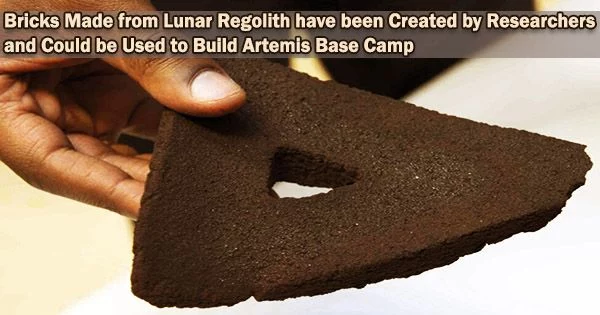Lunar regolith, which is the loose soil and rock that covers the surface of the moon, has been turned into bricks using a process called sintering. Sintering is a manufacturing process that involves heating a material to a temperature just below its melting point, causing the particles to bond together and form a solid mass.
Building materials for programs like Artemis can be transported far less frequently if they are used to construct facilities off-world. It seeks to construct an Artemis base camp that incorporates a contemporary lunar cabin, rover, and mobile house as part of NASA’s Artemis effort to establish a long-term presence on the moon.
Thanks to a recent finding revealed by a team of UCF researchers, this fixed habitat may be built with seawater and lunar regolith bricks.
The Department of Mechanical and Aerospace Engineering at UCF and Associate Professor Ranajay Ghosh’s research team discovered that lunar regolith bricks can resist the harsh conditions of space and are excellent building materials for extraterrestrial structures. The loose dirt, boulders, and other things that cover the moon’s surface are known as lunar regolith.
To create the bricks, Ghosh’s team in the Complex Structures and Mechanics of Solids (COSMOS) Lab used a combination of 3D printing and binder jet technology (BJT), an additive manufacturing method that forces out a liquid binding agent onto a bed of powder. In Ghosh’s experiments, the binding agent was saltwater, and the powder was regolith made by UCF’s Exolith Lab.
This research contributes to the ongoing debate in space exploration community on finding the balance between in-situ extraterrestrial resource utilization versus material transported from Earth. The further we develop techniques that utilize the abundance of regolith, the more capability we will have in establishing and expanding base camps on the moon, Mars, and other planets in the future.
Professor Ranajay Ghosh
“BJT is uniquely suitable for ceramic-like materials that are difficult to melt with a laser,” Ghosh says. “Therefore, it has great potential for regolith-based extraterrestrial manufacturing in a sustainable way to produce parts, components and construction structures.”
Green pieces, which were the weak cylindrical bricks produced by the BJT technique, were then baked at high temperatures to create a stronger structure. Bricks that were baked at lesser temperatures fell apart, while those that were exposed to heat up to 1200 degrees Celsius could resist pressures of up to 250 million times that of the Earth’s atmosphere.
According to Ghosh, the breakthrough paves the way for BJT to be used in the manufacture of materials and structures in space. Their research also shows that resources found in space can be used to construct structures off-world, which can significantly minimize the requirement to ship building supplies on missions like Artemis.
“This research contributes to the ongoing debate in space exploration community on finding the balance between in-situ extraterrestrial resource utilization versus material transported from Earth,” Ghosh says. “The further we develop techniques that utilize the abundance of regolith, the more capability we will have in establishing and expanding base camps on the moon, Mars, and other planets in the future.”
Peter Warren, Ghosh’s graduate research assistant, is the paper’s first author. Nandhini Raju, a doctoral candidate in mechanical engineering, Hossein Ebrahimi, a doctoral graduate in mechanical engineering, Milos Krsmanovic, and professors of aeronautical engineering Seetha Raghavan and Jayanta Kapat are co-authors on the paper.
Ghosh joined UCF in 2016 as an assistant professor in the Department of Mechanical and Aerospace Engineering and is a researcher with MAE’s Center for Advanced Turbomachinery and Energy Research. He manages the Complex Structures and Mechanics of Solids Laboratory, better known as the COSMOS Lab, where he and his team fabricate and design novel materials with the aid of computer models and experiments. He earned his doctorate in mechanical and aerospace engineering from Cornell University in 2010 and is a recipient of the U.S. National Science Foundation CAREER Award.
















